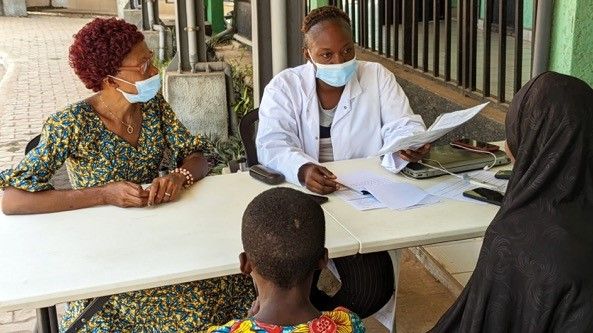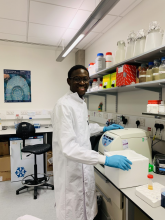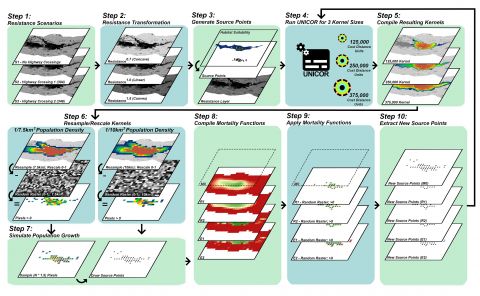Features
Patient recruitment is on-track in the Oxford-led DeTACT trial of safe, effective drug combinations to prevent the spread of artemisinin and multi-drug resistant malaria in Africa.
The global fight against malaria is at a critical point. Overall progress has now stalled and even worsened in some countries in Africa, where most of the world’s 627,000 deaths from malaria occurred in 2020.
The situation is becoming grave with recent studies confirming the growing prevalence in Rwanda and Uganda of P. falciparum malaria parasites partially resistant to artemisinins, which are the most important frontline anti-malaria drugs.
No new antimalarial drugs are expected in the near future. If multi-drug resistant falciparum malaria becomes established in East Africa and spreads to other parts of Africa, it is soon likely to compromise the efficacy of artemisinin-based combination therapies or ACTs — putting millions of Africans at risk of drug-resistant malaria infection and death.
The WHO has said this 'independent emergence of artemisinin partial resistance in the African Region is of great global concern.'
One possible solution — new drug combinations with artemisinins and two other frequently used antimalarial drugs (Triple ACTs or TACTs) — was found in 2020 by the large multi-centre, multi-country TRAC2 study to be highly efficacious even in places where ACTs were failing.
Before TACTs could be widely deployed to control artemisinin-resistance in Africa, however, their efficacy, safety and tolerability would first need to be confirmed in African populations, especially children.
 A child suspected to have malaria being screened for recruitment into the DeTACT Trial at the Centre National de Formation et de Recherche en Santé Rurale (CNFRSR), Maférinyah, Guinea. © MORU. Photographer: Mehul Dhorda.
A child suspected to have malaria being screened for recruitment into the DeTACT Trial at the Centre National de Formation et de Recherche en Santé Rurale (CNFRSR), Maférinyah, Guinea. © MORU. Photographer: Mehul Dhorda.Led by University of Oxford-affiliated researchers based in Bangkok at the Mahidol-Oxford Tropical Medicine Research Unit (MORU), the Developing Triple Artemisinin-based Combination Therapies (DeTACT) trial is currently studying in eight African and three Asian countries two new TACTs to generate evidence that they are effective first-line malaria treatments and support their deployment in Africa to prevent or delay the emergence of artemisinin and multi-drug resistant malaria in Africa.
Funded by UKaid administered through the Foreign, Commonwealth and Development Office (FCDO), DeTACT’s goals are ambitious.
'The emergence of artemisinin resistance in Africa is a serious concern, and its containment is paramount to avoid treatment failures in falciparum malaria in the future. TACTs can be an important contribution to this, both by delaying antimalarial drug resistance to the existing drugs, and by providing an effective treatment for multidrug resistant infections. DeTACT will provide the necessary evidence on TACTs, deliver a product that can be deployed, and will engage with national and global policy makers and other stakeholders to discuss the potential position of TACTs in the mix of antimalarial drugs,' says Professor Arjen Dondorp, the Principal Investigator of the DeTACT.
Besides comparing two existing ACTs (artemether-lumefantrine and artesunate-mefloquine) against two TACTs constituted of one additional drug added to each of these combinations (amodiaquine and piperaquine, respectively), DeTACT is conducting studies to forecast the impact of TACTs on controlling the spread or emergence of multidrug-resistant falciparum malaria leading to its elimination, and to examine the market readiness and ethical considerations of using TACTs across the malaria endemic world.
'The DeTACT Project includes modelling studies that will project the impact and cost-effectiveness of TACTs in preventing the spread of artemisinin resistance, explained Dr Chanaki Amaratunga, DeTACT Project Coordinator.'
'We are also conducting studies with all malaria stakeholders, starting from patients to researchers and policy makers, to elucidate the ethical and market aspects of their deployment. Along with the clinical trial, these studies constitute a comprehensive assessment of the expected advantages and potential barriers to the large scale use of TACTs,' said Dr Amaratunga.
Despite disruptions caused by the COVID-19 pandemic, DeTACT has already recruited over 700 patients, and aims to complete the recruitment of close to 4000 patients by early 2023.
The modelling, ethics and market positioning studies are well advanced and are expected to be completed by the end of 2022.
In addition, MORU has signed a memorandum of understanding with Fosun Pharma and Medicines for Malaria Venture (MMV) to collaborate with them to develop and pre-qualify fixed-dose combinations of TACTs prior to marketing them across Africa and the malaria endemic world.
'The DeTACT Trial will generate data not only on the efficacy and safety of TACTs but also on the pharmacokinetics of each of the drug components, including in malnourished children – a particularly vulnerable sub-population. In addition, there will be cutting-edge analyses, combining clinical trial data with that from whole genome and transcriptome studies, to improve our understanding of artemisinin and other antimalarial drug resistance,' said DeTACT-Africa Coordinator Dr Mehul Dhorda.
'We sincerely thank our partners conducting the field trials for maintaining their commitment to completing the trial in a difficult context,' Dr Dhorda added.
DeTACT is the third of three FCDO-supported multi-country, multi-site trials (TRAC and TRAC2) that have characterised artemisinin resistance and tested multi-drug resistant malaria treatments in South-East Asia. The work related to pharmacokinetics of antimalarials in malnourished children is supported by a grant from the Wellcome Trust.
Five graduate students currently studying at Oxford have been awarded £1,000 grants from the Vice Chancellor’s COVID-19 African Innovation Seed Fund for entrepreneurial projects aimed at addressing global challenges stemming from the pandemic.
Professor Louise Richardson, Oxford's Vice Chancellor, said, ‘I am proud to see how the five students have reimagined their research to address urgent global challenges created by the pandemic. Whilst completing their graduate courses in the midst of a global pandemic, they have unleashed their creativity and insight to support the most vulnerable in our societies.’
The COVID-19 African Innovation Seed Fund grants were awarded in partnership with the Oxford University Africa Society, during the 2021 Oxford Africa Conference. The five winners are reimagining their research and using their expertise to accelerate access to education, health services, and safe drinking water.
Held virtually in May this year, and introduced by Dr Tedros Adhanom, Director General of the WHO, the Conference highlighted innovations and progress in health, economics, climate and politics in Africa.
With their specific knowledge and engagement with the African context, they are uniquely positioned to tap into the vibrant Oxford innovation ecosystem to create purpose-focused solutions...The winners truly represent the explosion of talent that is in the African continent
Dr Watu Wamae
Dr Elisha Ngetich, President of the Africa Society, and a current DPhil candidate at Oxford said, ‘Innovation is the cornerstone of Africa’s future. It makes me extremely proud to see the cutting edge research and innovation being done by these students at Oxford and the potential this could have for the continent.’
Dr Watu Wamae, AfOx Health Innovation Platform lead, said, ‘The creativity and phenomenal ability of the five students to pivot their research to address real challenges in Africa is commendable. With their specific knowledge and engagement with the African context, they are uniquely positioned to tap into the vibrant Oxford innovation ecosystem to create purpose-focused solutions that will positively impact livelihoods. The winners truly represent the explosion of talent that is in the African continent.’
The Winners
Increasing access to Preterm care in a time of a pandemic
Josephine Agyeman-Duah

Josephine is a 3rd year DPhil candidate in the Nuffield Department of Women’s & Reproductive Health. Her research seeks to evaluate the effectiveness of a neurodevelopmental assessment tool for babies born pre-term. Such babies are at higher risk of neo-natal morbidity and developing mental health problems.
With the support received from the Vice Chancellor’s COVID-19 African Innovation Seed Fund, Josephine will be able to buy equipment and train more health assessors for the virtual platform.
She said, ‘My motivation for applying to the Oxford 2021 V-C COVID-19 African Innovation Seed Fund was to leverage the opportunity to promote a research idea by an African scholar at Oxford and to support an idea which will be a huge benefit to the African continent and globally. The availability of a platform for neurodevelopmental assessment in the time of a pandemic or where access to health centres is limited, will boost the possibility of scaling up neurodevelopmental screening.’
This innovation will have huge benefit even beyond the pandemic. Virtual screenings will allow health practitioners to reach more patients in a timely manner.
TGI career mobile app
Segun Afolaranmi

Segun is taking an MSc in Integrated Immunology. He is the co-founder of The Ganglion Initiative, an organisation supporting career development and entrepreneurship among secondary school students in Nigeria.
The pandemic significantly affected Nigeria’s already weak schools career counselling services. Segun’s team is building an innovative mobile app. It will allow The Ganglion Initiative to reach more students and schools digitally, providing comprehensive and tailored information on career and scholarship opportunities.
He said, ‘This award is in honour for the dedicated volunteers at The Ganglion Initiative who work tirelessly to achieve our vision, and the funding will support our efforts to reach more students by deploying the online tool.’
The app will simplify information on seemingly complex topics, such as choosing a career and applying to university, through explainer videos and puzzles. Users will also be able to chat with directly with volunteers enrolled in higher education.
Their aim is to reach at least 20,000 Nigerian students. The support from the Vice Chancellor’s COVID-19 African Innovation Seed Fund will help complete the product design of the app as well as online and offline publicity of the app.
Improving Water Pricing Strategies Amidst Ghana's COVID-19 Free Water Policy
Emmanuel Opoku

Emmanuel is taking an MSc in Water Science, Policy and Management. His innovation aims to ensure that the most vulnerable households in Ghana have access to safe drinking water amidst the pandemic.
Emmanuel aims to devise a strategy to subsidise water prices for the most vulnerable water users, by assessing their water affordability. Household water affordability is determined by finding the ratio of household’s expenses on water to their total expenditure/income. Based on the 2018 UN’s economic growth report, households whose water affordability is below 10% are considered vulnerable.
He said, ‘The Increasing Block Tariff water pricing strategy has been widely adopted by utilities in Sub-Saharan Africa, but it imposes differential affordability burden on low-income households and hinders utilities from fully recovering costs. This is a good opportunity for not only determining befitting subsidy beneficiaries but for developing cost reflective tariffs designs that could be adopted globally.’
Emmanuel has developed an innovative approach, calculating water affordability in 100 households over a 10-day period. From his analysis, households whose water affordability is below the 10% threshold will be marked as vulnerable. This will allow the Government to target vulnerable areas and provide proportionate subsidies on tariffs. .
His innovation has the potential to create long-lasting improvements in water-pricing techniques in Ghana. The support from the Vice Chancellor’s COVID-19 African Innovation Seed Fund will cover the travel and research costs.
Energy for Health Initiative
Godwin Nwangele

Godwin is taking an MSc in Energy Systems in Oxford’s Department of Engineering Science and his innovation aims to develop smart technology that connects solar power to hospitals.
One of the challenges facing the healthcare sector in Nigeria, and other African countries, is limited access to reliable electricity supplies. This challenge has been compounded by the pandemic, because the infrastructure needed to transport safely and store the vaccines requires steady supplies of power.
He said, ‘Winning the Vice Chancellor’s innovation award is a proud achievement for me. It is heartwarming to know that my idea is selected to build a resilient healthcare system in Africa. I am now motivated to work harder to complete this research, prototype it, and move to the implementation phase.’
This initiative seeks to conduct research using a Smart Sequential Loader (SSL) to provide solar power to hospitals, while cutting costs and achieving capacity optimisation. Not only will this be beneficial for vaccine equipment, but for the healthcare system and for those who depend on it.
Godwin will be using the Vice Chancellor’s COVID-19 African Innovation Seed Fund award to fund this research and obtain the device that will address this challenge. He also plans to partner with others on the African continent to roll out this solution beyond Nigeria.
The Right of Access to Educational Materials: International and Domestic Law
Sanya Samtani

Sanya is a final year DPhil student in Law. Her research offers constitutional tools to ensure access to educational material for people living in poverty and with disabilities in South Africa.
Despite the Bill of Rights in South Africa guaranteeing all people the right to education, the Copyright Act of 1978 prohibits people living in poverty and people living with sensory disabilities from access to educational materials such as textbooks.
She said, ‘Facilitating access to educational materials for all is key to knowledge generation and innovation, which in turn leads to a flourishing democratic society. South Africa's Copyright Amendment Bill is a positive step in the direction of inclusive access, grounded in constitutional values and the Bill of Rights.’
Sanya’s research highlights how these laws prevent millions of South Africans, who cannot afford a book, from accessing the material through photocopying. And that the law, which does not allow format shifting, precludes widespread use of assistive technologies, thus also denying access to people living with disabilities. As South Africa has entered into several lockdowns and tuition has been online, the copyright law, and the challenges it presents, have been exacerbated.
Sanya plans to use the grant to publish her research as an openly accessible monograph. This will be hugely valuable to those who are championing copyright reform and the access to education and learning materials in South Africa.
The law on marriage and civil partnerships, for both opposite and same sex couples, has been made equal – but not completely symmetrical; that is, concerning the option of converting one form of legal union into another, according to research by John Haskey, Associate Fellow at Oxford’s Department of Social Policy and Intervention published in Family Law.
Both same sex and opposite sex couples can become civil partners or they can marry. Consequently there are four possible ‘conversions’ of one form of legal union into another, only one of which is currently permissible - same sex civil partnerships can be converted to same sex marriages. The other three ‘conversions’ are not legally possible at present: same sex and opposite sex couples cannot convert from a marriage to a civil partnership, and opposite sex couples cannot convert from a civil partnership to a marriage.
One benefit of allowing all four conversions would be that couples could periodically reassess the form of their legal union and convert it to the alternative kind if they judged it appropriate. Such a review and reassessment might well be beneficial to the health of the relationship
John Haskey
An argument against two of these unavailable conversions is that the couples concerned did have the choice between the two legal unions: for example, opposite sex couples who formed a civil partnership did have the opportunity of marrying; similarly same sex couples who had married, could have opted instead for a same sex civil partnership, as the latter were introduced before the former.
In contrast, however, opposite sex couples who married earlier did not have the opportunity to have a civil partnership and there is the possibility that such conversions might be legislated. Other considerations and arguments might be deployed in favour of legislating the remaining two conversions.
According to John Haskey, ‘One benefit of allowing all four conversions would be that couples could periodically reassess the form of their legal union and convert it to the alternative kind if they judged it appropriate. Such a review and reassessment might well be beneficial to the health of the relationship.
'Undoubtedly perceptions about the characteristics of civil partnerships and marriages differ, and these differences may well vary for different age groups, so that conversions may be thought to allow some flexibility - a potential benefit - in the form of legal union with its associated expectations.’
He adds, ‘Another benefit of allowable conversions is that if a partner or spouse has a gender change, they can still remain married or as a civil partner with no disruption to their civil partnership or marriage - the union just changes for example, from an opposite sex one to a same sex one.’
The article reveals, the vast majority of same sex couples have not opted to convert their civil partnerships to marriages. John Haskey writes that, after December 2005, when same sex civil partnerships were introduced, 13,000 couples formed civil partnerships in the following nine months of 2006. After the initial rush, the monthly numbers fell to less than 1,000 a month and a seasonal pattern quickly emerged. Up to the end of 2017, he estimates, some 63,000 same sex partnerships had been formed.
Same sex marriage was introduced in March 2014, and the option to convert a same sex civil partnership to a same sex marriage in December 2014. The article estimates that up to the end of 2017, 23% (14,000) of civil partners had opted for conversion to marriage.
An important element in the argument for having, and retaining, civil partnerships has been that they avoid what many see as the paternalistic aspects of marriage, the couple preferring, it is claimed, to be equal partners, rather than husband and wife with their traditional roles
John Haskey
According to John Haskey, ‘The fact that a large proportion of civil partners have not converted their partnership may well reflect their contentment with the new status. Alternatively, they may have been unaware of the facility to convert, or even (erroneously) considered themselves either married or ‘as if married’.’
He adds, ‘An important element in the argument for having, and retaining, civil partnerships has been that they avoid what many see as the paternalistic aspects of marriage, the couple preferring, it is claimed, to be equal partners, rather than husband and wife with their traditional roles. (Inevitably, though, one wonders whether, had same sex marriage been legislated early and first, there would have been any civil partnerships on the statute book at all.)’
John Haskey concludes, ‘Overall, there has been extraordinary progress over the last two decades, and much of the advance can be attributed to the adherence to the principles of equality and non-discrimination, which, no doubt, will also play an important part in future reform. Three new legally recognised relationships in the space of less than two decades contrasts with centuries of having only marriage is remarkable, and may signify a new spirit of progressivism.’
The full article can be read here: Perspectives on civil partnerships and marriages in England and Wales: aspects, attitudes and assessments (familylaw.co.uk)
Concerns over missed education for young people have spread around the world with schools and colleges firmly shut for long stretches because of COVID-19. In England, the Government has announced large-scale funding to help education recover from the devastation of the pandemic. As part of this, the very youngest children, who have poor oral language skills and have been particularly affected by the switch to online learning, will be able to access specialised help – key to academic success.
It is widely recognised that language skills are fundamental to many aspects of cognitive and psychosocial development, and that poor language skills are a barrier to educational success.
The current rollout of the NELI programme in English primary schools is a stunning example of how basic academic research can be translated into practical application at large scale
Developed by an Oxford team, led by Professors Charles Hulme and Maggie Snowling, the Nuffield Early Language Intervention (NELI) programme improves oral language skills in young children. According to research by this group, there can be a transfer effect with oral language interventions, leading to improved reading comprehension.
As a result of official funding, it is hoped that all primary schools in England that want it, will benefit from the Oxford oral language programme. Last autumn, the Department for Education announced a £9 million investment in the programme, with a further £8 million announced for next academic year. In this academic year, this funding has enabled the programme to be delivered by some 6,500 schools. Schools wishing to register interest, can do so here.
The current rollout of the NELI programme in English primary schools is a stunning example of how basic academic research can be translated into practical application at large scale.
Children’s oral language skills are a critical foundation for the whole of formal education....Good language skills underlie a child’s ability to learn to read and to master arithmetic
Professor Charles Hulme
Professor Hulme says, ‘Children’s oral language skills are a critical foundation for the whole of formal education. To learn in the classroom, children need to understand what is said to them and be able to express their thoughts and feelings. Good language skills underlie a child’s ability to learn to read and to master arithmetic.’
Dr Gillian West, a member of the research team, comments, ‘Language skills are also critical for children’s social and emotional development, and their ability to make friends.’
Language skills can vary greatly among social groups. According to Professor Hulme, ‘It is well established that children from socially disadvantaged backgrounds often enter school with weak language skills. The NELI programme offers the potential to help reduce social inequalities in educational outcomes and can also be used effectively with children for whom English is an additional language.’
Language skills are also critical for children’s social and emotional development, and their ability to make friends
Dr Gillian West
The schools taking part identify five or six children in each reception class with the weakest oral language skills.
Last month, a study of NELI’s effects by Professor Hulme showed that the programme produced sizeable improvements in children’s language skills and small improvements in word reading skills.
Teachers and teaching assistants are trained to deliver the NELI programme using an online training programme, developed by the Oxford team, and delivered on the FutureLearn platform. The schools taking part identify five or six children in each reception class with the weakest oral language skills.
These children receive the programme get two 30 minute group sessions each week and three 20 minute individual sessions. During these periods, the children are involved in speaking and listening activities including storytelling and learning new words. Once staff are trained, NELI can be implemented in schools year after year, benefitting generations of children.
Identifying those children who would benefit from the programme is key. Teachers need a way to identify language weaknesses when using the NELI programme. A ‘LanguageScreen’ assessment app has been developed by Professor Hulme’s research group in collaboration with Dr Mihaela Duta and Dr Abhishek Dasgupta in Oxford’s Department of Computer Science. It is now available to all schools via an Oxford spinout company (LanguageScreen.com).
Dr Duta says, ‘It is a great pleasure to bring software engineering to bear on an issue of such social importance.’
Children from socially disadvantaged backgrounds often enter school with weak language skills. The NELI programme offers the potential to help reduce social inequalities in educational outcomes and can also be used effectively with children for whom English is an additional language
Professor Hulme
The Education Endowment Foundation, with private equity enterprise ICG, provided funding to develop online training for the programme, ensuring it could be offered in a social-distanced manner as well as at national scale.
LanguageScreen runs on a tablet or phone and gives teachers an accurate and rapid assessment of a child’s language ability via a secure automated online report. LanguageScreen will allow teachers to monitor the development of children’s language skills.
By David Macdonald, Director of WildCRU
Tigers are in dire straits, with prospects for the Indochinese subspecies among the most dire of all. This is why I want to spotlight the work of Eric Ash for leading research on one of the few known breeding sites for the subspecies anywhere in the world.
Eric Ash, a doctoral student at Wildlife Conservation Research Unit (WildCRU), part of the University of Oxford’s Department of Zoology, has dedicated himself to the conservation of tigers in Thailand for the last nine years. Now, with our collaborators at the Freeland Foundation, he has led our new paper published in the journal, Land.
The under-studied and endangered Indochinese tiger faces extinction and continuing declines, a distinction that unhappily makes the subspecies a candidate for Critically Endangered status
The under-studied and endangered Indochinese tiger (Panthera tigris corbetti) faces extinction and continuing declines, a distinction that unhappily makes the subspecies a candidate for Critically Endangered status. Thailand plays a crucial role in its conservation – there are few known breeding populations in other range countries. Our work has focused on Thailand’s Dong Phayayen-Khao Yai forest complex (DPKY), a group of five protected areas and UNESCO World Heritage Site, where Eric and Freeland Foundation, in partnership with the Thai-government and Panthera, conducted a massive camera-trapping study to find out just how the tigers there were faring.

Importantly, we evaluate the sensitivity of population connectivity models to the variation and interaction of key factors, such as landscape resistance to movement, dispersal ability, population density, and mortality, over a series of timesteps. The article, led by researchers at WildCRU, offers insight into potential tiger range expansion scenarios.
The authors utilize spatially and temporally-dynamic simulations to model tiger population changes and dispersal from this landscape to potential habitat elsewhere in Thailand, Cambodia, and Laos, areas where tigers are thought to be extinct.Our new paper builds upon the remarkable news that this vital population of tigers could be recovering, as evidenced by signs that tigers are beginning to disperse from core areas into frontier habitat from which they had previously been extirpated
Our new paper builds upon the remarkable news that this vital population of tigers could be recovering, as evidenced by signs that tigers are beginning to disperse from core areas into frontier habitat from which they had previously been extirpated.
This was a huge analytical effort, informed by an even greater effort under arduous conditions in the field which generated over a million camera-trapping images and almost 80,000 collective trap nights over nine years. The team ran advanced analyses, requiring months of high-level computing, which produced 24,300 simulations of population, landscape connectivity, and density of dispersing individuals across the landscape to evaluate the effect of key factors.
The result? The computer models suggest that the tiger’s fate is extremely sensitive to variations in mortality and dispersal ability – and, over time, these two factors interact to strongly affect predictions. For the technical aficionado: incorporation of an explicit mortality component, reflecting differences in probability of survival across the landscape, combined with increased dispersal ability, resulted in considerably lower estimates of population and connectivity.
These results are hugely important for tigers, but they also offer an important lesson more broadly: given the importance of population connectivity modelling in cutting-edge ecological research, the approach of the WildCRU team can inform future assessments for rare or threatened species where empirical data are scarce – a challenge faced by many researchers around the world.
This study is among the first explicitly to evaluate the interaction of dispersal ability and mortality on population size, distribution and connectivity in a spatially and temporally explicit dynamic framework. The authors are convinced that future studies should adopt this approach, explicitly accounting for mortality risk across landscapes and potential interactions with dispersal ability over time. The ways in which these factors can vary over time in reality can drastically affect the simulated results. Importantly, for translating this research into impact, the study identified potential population growth and range expansion scenarios for tigers along with key factors relevant to their long-term management across this key landscape in Southeast Asia.
'How Important Are Resistance, Dispersal Ability, Population Density and Mortality in Temporally Dynamic Simulations of Population Connectivity? A Case Study of Tigers in Southeast Asia', Ash, E.; Cushman, S.A.; Macdonald, D.W.; Redford, T.; Kaszta, Ż. Land 2020, 9, 415. https://www.mdpi.com/2073-445X/9/11/415
- ‹ previous
- 2 of 9
- next ›





 A green fuels breakthrough: bio-engineering bacteria to become ‘hydrogen nanoreactors’
A green fuels breakthrough: bio-engineering bacteria to become ‘hydrogen nanoreactors’ Oxford's student voices at COP29
Oxford's student voices at COP29 Teaching the World’s Future Leaders
Teaching the World’s Future Leaders  A blueprint for sustainability: Building new circular battery economies to power the future
A blueprint for sustainability: Building new circular battery economies to power the future Oxford citizen science project helps improve detection of antibiotic resistance
Oxford citizen science project helps improve detection of antibiotic resistance The Oxford students at the forefront of the fight against microbial resistance
The Oxford students at the forefront of the fight against microbial resistance  The hidden cost of AI: In conversation with Professor Mark Graham
The hidden cost of AI: In conversation with Professor Mark Graham  Astrophoria Foundation Year: Dr Jo Begbie reflects on the programme’s first year
Astrophoria Foundation Year: Dr Jo Begbie reflects on the programme’s first year World Malaria Day 2024: an interview with Professor Philippe Guerin
World Malaria Day 2024: an interview with Professor Philippe Guerin